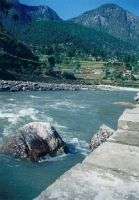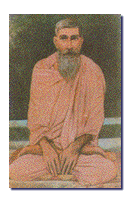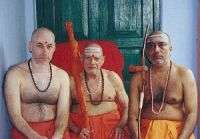Siddhayoga
This article concerns only the Tirtha lineage of Siddhayoga. For other uses see Siddha Yoga (disambiguation)

The Tirtha lineage of Siddhayoga is a mystical sect of Shaivite Hinduism that relies on direct experience of life-force or Kundalini Shakti and understanding of Tantric scriptures (shastras). It holds the guru-disciple relationship to be of primary importance. Shakti is said to be automatically infused into the disciple (shisya) by the Guru[1] in a process called Shaktipat. (see also Satguru)
There are many Siddhayoga lineages and many other groups not using the name that speak in terms of the infusion of kundalini shakti. Some lineages originated from the same source, others are completely unrelated.[2] Siddhayoga is similar to sahajayoga, mahayoga or siddhamahayoga. Similar teachings may be traced back at least to the Tantric masters such as the scholar Abhinavagupta.[3] Shakti is held to be the energy of a universal soul, of which direct experience is available regardless of religion; thus siddhayoga is sometimes considered a universal rather than a strictly Hindu practice.
Scriptural sources

Siddhayoga aims to uncover an eternal source of abundance for all to share – peace, creativity, spiritual energy and eternal soul. The guru makes this happen for the disciple.[4] Its most important text is the Yoga Vani.
The siddhayoga guru prepares the kundalini shakti which automatically gets infused in the disciple at the muladhara chakra, awakening and raising spiritual energy up the Sushumna[5] Various ancient texts discuss this effect of nearness to the guru. The Kularnava Tantra[6] has; "An intelligent person should regard this teacher as their preceptor by whose contact inexpressible bliss is produced in the disciple." and the Yoga Vasistha[7] confirms; "A real preceptor is one who can produce blissful sensation in the body of the disciple by their sight, touch, or instructions."
Siddhayoga is said to be an internal transformation, allowing a person to grow more into their nature regardless of their outer path, rites and rituals; what they do and how they do it in the outer world is unique to their own individual path (dharma). One who yearns to connect with their soul or God, who strives for mental peace and harmony with all people, animals, and nature, who tries to live in balance with nature's rhythms and who aims to live purposefully will find these higher desires fulfilled in experiencing of soul and developing of inner divine love.
Siddhayoga lineage

Swami Shankar Purushottam Tirtha descended from two monastic lines. He was first initiated into Siddhayoga by Swami Narayana Dev Tirtha [born circa 1879], whose own spiritual lineage was through Swami Gangadhara Tirtha. Swami Shankar Purushottam Tirtha then took sannyas under Jagadguru Shankaracharya Swami Bharati Krsna Tirtha in Puri. During Jagadguru Shankaracharya Swami Bharati Krsna Tirthaji's visit to America, Swami Shankar Purushottam Tirtha was asked to maintain the holy seat of Shankaracharya of Puri Govardhan Mutt. Swami Shankar Purushottam Tirthaji was not keen to be bound by the obligations pertaining to the office of Shankaracharya, including administrative responsibilities. His greater objective was to spread the thought of God among all people. As a result, brushing aside the honour of and fascination for the position of Shankaracharya, he set out, proceeding to the north in the direction of the Himalayas, always an attraction to yogis, seers, and sages as the ideal place for sadhana. The The king of Tehri Garhwal, appreciative of the blessings he received from Swamiji, expressed his desire to donate a vast stretch of land by the Ganga, but Swamiji accepted only a modest plot after repeated entreaties of the king. Thus, the ashrama named "Shankar Math" Uttarkashi was established in 1933. Later, another Math in Varanasi's Chhoti Gaibi, named "Siddhayogashram" was founded in 1934. Swami Shankar Purushottam Tirtha wrote several books such as Yogavani, Japa Sadhana, and Guruvani which were originally written in Bengali, later translated into Hindi. He also wrote a short treatise in English, entitled Who Am I?[8]
Swami Shankar Purushottam Tirtha [1888-1958] was the guru of Swami Narayana Tirtha [ -2001]. Swami Vishnu Tirtha was another disciple of Swami Shankar Purushottam Tirtha. He was initiated in 1939.[9] Swami Shivom Tirtha, a disciple of Swami Vishnu Tirtha,[10] has a website dedicated to him that explains the Tirtha Siddhayoga lineage tree in more detail.[11]
The Tirtha lineage of Jagadguru Shankaracharya Swami Bharati Krsna Tirtha [1884-1960] traces itself back to Sri Adi Shankaracharya. In legend the lineage (parampara) began when Lord Narayana passed the eternal Vedic wisdom to Brahma, Brahma to Vasishtha, onto Shakti, to Parashara, to Veda Vyasa, and to Shuka. Thus far the lineage was from father to son. From Shuka it was passed on from guru to shishya, to Patanjali, then to Gaudapada, Govinda, Chandra Sharma and so to Adi Shankara. This began the tradition of wandering monks. Vyasa told Govinda of the advent of the incarnation of Shiva as Adi Shankara, to meet and give him sanyas diksha, Shankara's purpose in incarnating was to comment on the Brahma Sutras.[12] Shankaracharya set up four religious seats in the north, south, east and west of India to act as a lighthouse to guide religious seekers towards the truth for the millennia to come and also set up the ten monastic orders. 1) Tirtha, 2) Ashrama, 3) Vana, 4) Aranya, 5) Giri, 6) Parvata, 7) Sagara, 8) Saraswati, 9) Bharati, 10) Puri.[13]
Faith in the guru
As with much Hindu or Vedic mysticism, Siddhayoga's goal of life is to realize one is eternal soul and not this body.[5] Suffering is said to be caused by identifying with body, emotions, or thoughts, rather than with true nature.[15]
The rules of a discipline may become unnatural because they are artificially imposed: even when doing one's best to remain balanced and free one often finds oneself once again bound. Siddhayoga says that through the grace of a Siddhayoga guru all the work is done for you.[5] You do not force anything; you are not charged anything or asked for anything by the guru – so there is no conflict of interest.[16] One gains peace through direct experience of peace, not from intellectual knowledge of peace. Once peace is felt, the intellect confirms it.
This does not suggest people get a 'free ride' by following a Siddhayoga guru. Siddhayoga is said to be for those people who take responsibility for their lives, who are self-reliant, whose focus in life is to help others, the creatures, and Mother Nature, who aim for inner and outer balance in life, eat sensibly[17] and healthfully, live a life of moderation and seek to be purposeful in life.
- birds cannot fly in the air with the help of a single wing, but they can do so with the help of both. So the devotee cannot move in the spiritual atmosphere leading to Salvation with the help of knowledge of yoga alone. The devotee can attain salvation with the help of both knowledge and yoga.[18]
Current Siddhayoga gurus and ashrams
India

On 2 March 2001, Swami Narayana Tirtha died at Siddhayogashram in Varanasi.
Swami Atmananda Tirtha, who is a disciple and successor of Swami Narayana Tirtha, is the current Mathadhyaksha of all the ashrams in India – including the Siddhayoga Ashram in Varanasi and the Shankar Math in Uttar-Kashi. He speaks and writes fluently in Bengali, Hindi, and English.
Shankar Math is located in Uttarkashi, in the Himalayas (State: Uttaranchal). It was donated to Swami Shankar Purushottam Tirtha by the raja (king) of the region, who received blessings from Swami Shankar Purushottam Tirtha. Siddhayogashram is located in Chhoti Gaibi, Varanasi, and was built by Swami Shankar Purushottam Tirtha's disciples who wished him to live closer to them, since, in those days, a visit to Shankar Math in Uttarkashi required one to walk for 2 weeks from Rishikesh.
Siddha Ashram is located in Ujjain, Madhya Pradesh of Central India. The spiritual preceptor is Mahamandaleshwara Swami Nardananda Tirtha, a senior disciple of the late Swami Shivom Tirtha. Swami Nardanand is famous for constructing the world's largest mercury Shiva Lingam, Paradeshwar Mahadev weighing 2500 kilograms. He teaches Kundalini Yoga, Advaita Vedanta, and Tantra around the world.
America
Swami Narayana Tirtha's successor in America is Swami Sadashiva Tirtha, who also runs the ashram website, SwamiNarayanTirtha.org. He speaks English, Hindi and Bengali and has studied Ayurveda, Jyotish, and Vastu shastras. He is the author of Bhagavad Gita for Modern Times, and the Ayurveda Encyclopedia. Swami Narayan Tirtha Math was founded by Swami Sadashiva Tirtha in New York, USA.
References
- ↑ Tirtha, Swami Shankar Purushottam (1992). Yoga Vani: Instructions for the Attainment of Siddhayoga. New York: Sat Yuga Press. pp. 2–4."The easy way of attaining it (salvation) is said to be Siddhayoga...Siddhayoga or Siddhimarga is that means by which yoga (union) can be attained without difficulty...Siddhayoga is attained by the infusion of spiritual force through the good grace of a saintly preceptor...Siddhayoga or Siddhimarga is nothing but the knowledge of the unity of Self and Brahma..."
- ↑ Siddha Mahayoga FAQ
- ↑ Siddha Mahayoga FAQ
- ↑ Swami Sadashiva Tirtha. Founder, Swami Narayan Tirtha Math; Author, Bhagavad Gita for Modern Time& Ayurveda Encyclopedia. Personal conversation, 2007
- 1 2 3 Yoga Vani, 2
- ↑ quoted in Yoga Vani, 28
- ↑ quoted in Yoga Vani 27
- ↑ Swami Shankar Purushottam Tirtha's Yoga Vani: Instructions for the Attainment of Siddhayoga and Guru Bani: 100 Ways to Attain Inner Peace have been published in Bengali, Hindi, and English.
- ↑ "Swami Vishnu Tirth Ji Maharaj". Retrieved 2007-09-04.
- ↑ "Swami Shivom Tirth Ji Maharaj". Retrieved 2007-09-04.
- ↑ "Gurus of Tirth Lineage". Retrieved 2007-09-04.
- ↑ Kuppuswami, A (1972). Sri Bhagavatpada Shankaracharya. Varanasi: Chokhamba Sanskrit Series.
- ↑ Saraswati, His Holiness Jagadguru Sri Chandrasekharendra; Sri Shankaracharya of Kanchi Kamakoti Pitha (1988). Adi Shankara, His Life and Times. Mumbai: Bharatiya Vidya Bhavan.
- ↑ Tirtha, Swami Narayan Tirtha (2000). Guru Ka Khamrit (in Bengali). Siddhayogashram, D60/23 Choti Gaibi, Varanasi 221010, India: Siddhayogashram. p. 323.
- ↑ Yoga Vani, 9-10
- ↑ Yoga Vani, 30
- ↑ Yoga Vani, 80-88.
- ↑ Yoga Vani, 5-6.